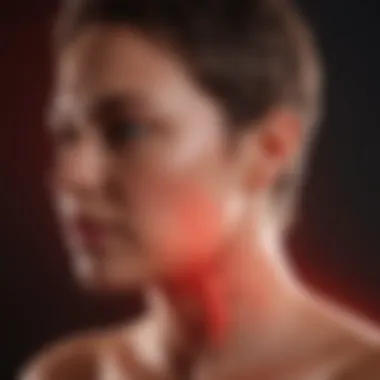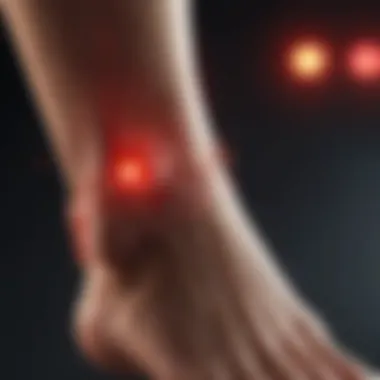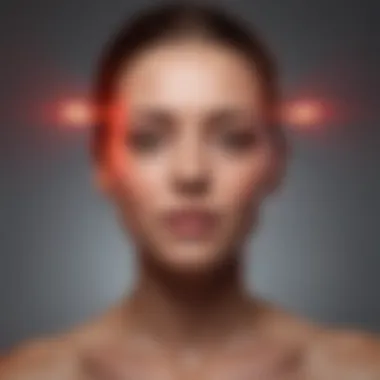Red Light Therapy for Managing Peripheral Neuropathy


Intro
Peripheral neuropathy, often an uninvited guest in the lives of many, brings with it a slew of complications ranging from numbing sensations to excruciating pain. This condition results from the damage inflicted on peripheral nerves, significantly impacting daily functioning and quality of life. Those who grapple with this ailment often find themselves searching for effective relief methods. One treatment that has garnered attention in recent years is red light therapy.
Red light therapy, a modality originally harnessed in the world of medicine, is now emerging as a salient option for those experiencing the discomfort brought on by peripheral neuropathy. Its underlying mechanism, which focuses on stimulating cellular repair and reducing inflammation, strikes a chord with those seeking alternative treatments. With the promise of alleviation at hand, it becomes essential to comprehend not just the concept but also the nuances surrounding its application in treating peripheral nerve pain.
This article delves into the scientific basis of red light therapy, exploring how it functions within the body and what empirical evidence supports its use in managing nerve-related issues. Clinical findings, patient case studies, and recommended practices will enrich your understanding of this innovative therapy, enlightening readers who range from students and researchers to professionals in healthcare.
Through this exploration, we aim to offer a detailed guide on how red light therapy can serve as a tool in the management of peripheral neuropathy, addressing both the immediate relief and the broader implications for nerve health.
Understanding Peripheral Neuropathy
Understanding peripheral neuropathy is crucial in the current medical landscape, especially since millions suffer from this condition that impacts quality of life. It goes beyond symptoms like pain and numbness; it ultimately interferes with everyday activities and well-being. Gaining insights into peripheral neuropathy not only helps patients navigate their experiences but also informs treatment strategies for professionals looking for effective interventions.
Definition and Types of Peripheral Neuropathy
Peripheral neuropathy is defined as a disorder that results from damage to the peripheral nerves – the nerves outside the brain and spinal cord. This damage can arise from various causes, leading to different types of neuropathy. Some common varieties include:
- Diabetic Neuropathy: Often seen in individuals with diabetes, this type occurs due to prolonged high blood sugar levels damaging nerves.
- Idiopathic Neuropathy: In many cases, the precise cause is unknown, falling into this category with no identifiable reasons.
- Alcoholic Neuropathy: Caused by chronic alcohol abuse, it involves nutrient deficiencies, particularly thiamine, contributing to nerve damage.
- Chemotherapy-Induced Neuropathy: A common occurrence in patients undergoing chemotherapy, this type involves nerve damage as a side effect of various cancer treatments.
Understanding these types aids in diagnosing and formulating approaches tailored to varying patient needs.
Symptoms and Diagnosis
The symptoms of peripheral neuropathy widely differ based on individual types and the nerves involved. People might experience:
- Tingling or burning sensations
- Muscle weakness
- Sensitivity to touch
- Numbness, often starting in the toes or fingers
Diagnosing peripheral neuropathy involves several steps. Physicians often start with a thorough medical history and physical examination. They might recommend
- Nerve conduction studies: Assess how well electrical signals travel through the nerves.
- Electromyography (EMG): A test to evaluate the electrical activity of muscles.
- Blood tests: To check for underlying conditions, like diabetes or vitamin deficiencies.
Identifying these symptoms accurately can prompt timely interventions, preventing further nerve deterioration and managing discomfort.
Common Causes and Risk Factors
A variety of factors contribute to the development of peripheral neuropathy, making understanding these elements vital. Key causes include:
- Diabetes: Over half of diabetic individuals develop neuropathy, highlighting the importance of blood sugar control.
- Infections: Certain infections, such as Lyme disease or shingles, can lead to nerve damage.
- Autoimmune diseases: Conditions like rheumatoid arthritis or lupus may impact nerves through inflammation.
- Physical injury: Traumas or repetitive stress injuries from work-related activities can damage peripheral nerves.
- Genetic mutations: Rare hereditary conditions might predispose individuals to nerve damage.
While some factors, like genetics, may be beyond control, recognizing lifestyle choices—such as excessive alcohol consumption or smoking—can help mitigate risks.
Understanding the nuances of peripheral neuropathy equips individuals and healthcare providers to address this complex condition holistically, especially as emerging therapies like red light therapy show promise in tackling these nerve-related challenges.
The Mechanism of Red Light Therapy


Understanding the mechanism behind red light therapy is crucial in comprehending its potential benefits for those suffering from peripheral neuropathy. This section dives into how light at specific wavelengths can affect biological processes, particularly in nerve function and repair, offering insights into its practical applications and therapeutic promise.
Basic Principles of Photobiomodulation
Photobiomodulation is the science that underpins red light therapy. This term refers to the process where specific wavelengths of light, typically in the red and near-infrared spectrum, penetrate the skin and are absorbed by cells. When this happens, it stimulates mitochondrial activity within cells, leading to an increase in the production of adenosine triphosphate (ATP). ATP is essential; it acts like the fuel that powers cellular functions.
By utilizing these wavelengths, the therapy harnesses light's energy to encourage biological responses. Several studies suggest that the range of 600 to 1000 nanometers is particularly effective, making devices that emit light within this wavelength range suitable for therapeutic purposes. This process is not merely about shining a light; it's about guiding the body's innate healing abilities using energy from outside.
Cellular Effects of Red Light
When red light reaches cells, it triggers a cascade of biochemical reactions. One significant effect is the reduction of oxidative stress within cells. Oxidative stress occurs when there’s an imbalance between free radicals and antioxidants in the body, resulting in cellular damage.
- Stimulated cellular repair: Increased ATP production promotes healing by enhancing cellular metabolism.
- Enhanced inflammation response: Red light therapy has shown to modulate inflammatory responses, potentially reducing chronic inflammation associated with neuropathy.
- Increased circulation: The therapy also promotes vasodilation, thereby improving blood flow to affected areas. Enhanced circulation can bring in more nutrients, which is vital for nerve repair and function.
These cellular effects are not just abstract concepts but form the bedrock of why red light therapy could be beneficial for peripheral neuropathy. As nerve cells require significant energy to function properly, effectively stimulating these cells may lead to improved outcomes.
Impact on Nerve Function and Repair
The effects of red light therapy on nerve function are an evolving area of research. Studies have indicated that relevant light exposure can not only aid in nerve regeneration but can also enhance overall nerve function. Some key impacts include:
- Reduction in neuropathic pain: Clinical studies suggested a significant decrease in pain for patients engaged in red light therapy protocols.
- Improved nerve signal transmission: Enhanced cellular metabolism might support the effectiveness of signal transmission along nerve pathways, leading to better communication between nerves and muscles.
- Facilitation of myelin sheath repair: The myelin sheath is a protective covering that insulates nerve fibers. Its repair can enhance nerve function and repair processes.
An important point to recognize is that the effectiveness of red light therapy can vary depending on several factors, including the device used, treatment duration, and individual patient characteristics. As ongoing research sheds light on standardized protocols, red light therapy may become increasingly integrated into treatment plans for peripheral neuropathy.
Understanding the associated mechanisms is key to realizing the full therapeutic potential of red light therapy in managing peripheral nerve injuries.
Overall, exploring the mechanisms of red light therapy presents a promising horizon for peripheral neuropathy treatment, suggesting that this biophotonic therapy may improve quality of life for those grappling with nerve damage.
Evidence Supporting Red Light Therapy
Red light therapy has gained traction as a potential treatment for a variety of health conditions, and its application for peripheral neuropathy is particularly noteworthy. As researchers and clinicians explore the landscape of pain management and nerve health, solid evidence is paramount. Clinical trials, case studies, and comparative analyses provide critical insights that elucidate the effectiveness of red light therapy. Highlighting these elements not only sheds light on how this therapy works but also aids patients, medical professionals, and researchers in making informed decisions regarding treatment options for peripheral neuropathy.
Clinical Studies and Findings
Numerous clinical studies have been conducted to explore the effects of red light therapy on patients suffering from peripheral neuropathy. One such study involved a randomized controlled trial with participants experiencing diabetic neuropathy. The findings showed significant reductions in pain levels among those receiving red light therapy compared to the control group. Not only did participants report a marked decrease in discomfort, but objective measures of nerve function also indicated improvement.
Another pivotal study analyzed the effects over a series of red light treatments, revealing that patients exhibited enhanced sensory functions. The improvements were noted over several weeks, and the results suggested that repeated exposure to red light can lead to sustained benefits. Additionally, publications in peer-reviewed journals have corroborated these findings, reinforcing the notion that red light therapy could serve as a valuable adjunctive treatment.
"The incorporation of red light therapy into standard treatment protocols could potentially transform approaches to managing peripheral neuropathy."
Case Reports and Success Stories
Beyond clinical trials, individual case reports have painted a vivid picture of the positive changes experienced by patients undergoing red light therapy. For instance, one notable case involved a middle-aged woman whose life was severely impacted by chronic pain due to peripheral neuropathy stemming from chemotherapy. After several sessions of red light therapy, she reported not only a considerable relief from pain but also improved mobility, which had been a significant barrier in her daily life.
Another compelling story comes from a patient struggling with post-surgical nerve damage. After integrating red light therapy into their recovery regimen, the patient saw a notable decrease in symptoms like numbness and tingling, which plagued them for months. These personal stories are critical as they offer evidence that resonates beyond statistical significance; they reflect real-life improvements in quality of life, encouraging further exploration and acceptance within the medical community.


Comparison with Traditional Treatments
When juxtaposed with traditional treatment modalities for peripheral neuropathy, red light therapy presents several advantages. Conventional treatments such as medications or invasive procedures often carry a host of side effects and can lead to patient non-compliance. In contrast, red light therapy is generally deemed safe, well-tolerated, and non-invasive.
A comparative study highlighted that while medication management may provide short-term relief, the long-term benefits of red light therapy showed promise without the burden of pharmacological side effects. Patients also reported feeling more empowered in their treatment journey when opting for alternatives like red light therapy, suggesting an improved connection to their healing process. Furthermore, traditional therapies often focus on symptom relief rather than addressing underlying nerve repair, a critical aspect where red light therapy shines, promoting cellular regeneration and facilitating recovery.
In summary, the evidence supporting red light therapy for peripheral neuropathy is compelling, entwining scientific research, real-world success stories, and a favorable comparison against traditional treatments. As we delve deeper into the subsequent sections of the article, we will further unravel practical applications and essential guidelines surrounding this innovative therapy.
Practical Applications of Red Light Therapy
When considering innovative approaches to mitigate the challenges posed by peripheral neuropathy, the practical applications of red light therapy stand out remarkably. This section will delve into the various tools and methodologies that have emerged in this field. Understanding these elements can lead to more effective management of nerve-related conditions and offers a glimpse into the therapeutic potential that red light therapy holds.
Devices and Technologies Available
In the current market, there is an array of devices designed for implementing red light therapy. The technology varies significantly in terms of size, output intensity, and usability. Some notable options include:
- LED Light Panels: These panels provide a broad coverage area and are often used in clinics and spa settings for treating multiple patients simultaneously. They are engineered to emit specific wavelengths of light that are effective in stimulating cellular activity.
- Handheld Devices: Handy and portable, these devices are perfect for home use. They allow individuals to target specific areas that experience discomfort, making self-treatment very accessible.
- Light Therapy Caps and Wraps: Specifically designed for treating the head and joints, these items integrate flexibility with functionality, allowing deeper penetration of light into tissue.
- Full-Body Light Beds: These are more sophisticated setups typically found in wellness centers. They provide full-body exposure to red light, offering a comprehensive treatment experience.
Each type of device comes with its own set of advantages, enabling users to choose one that best meets their specific needs and lifestyle.
Treatment Protocols and Dosage Guidelines
Establishing a clear treatment protocol is fundamental when considering red light therapy for peripheral neuropathy. Common guidelines include:
- Frequency: Users may benefit from sessions three to five times per week, depending on the severity of their condition.
- Duration: A typical session may last between 10 to 20 minutes per targeted area.
- Wavelength: Most studies suggest using wavelengths between 600 to 900 nm for optimal results, as this range has shown promise in stimulating cellular responses effectively.
It's crucial for individuals to listen to their bodies, adjusting the protocol based on how they respond.
Integrating Red Light Therapy in Clinical Practice
For healthcare providers looking to integrate red light therapy into their clinical practices, a calculated approach is key. This starts with:
- Assessment of Patient Needs: Understanding each patient's condition can guide the implementation process.
- Education and Training: Practitioners should familiarize themselves with various devices and treatment methods to offer patients accurate information about procedures and expectations.
- Collaboration with Other Treatments: Red light therapy should complement existing treatment plans, including physical therapy or medication, rather than act as a standalone solution.
By fostering an environment where red light therapy becomes an integral aspect of patient care, practitioners can address peripheral neuropathy more effectively and holistically.
Red light therapy holds promise not just as a standalone treatment for peripheral neuropathy but as part of a broader therapeutic strategy that includes patient education and interdisciplinary approaches.
Safety and Side Effects
When dealing with therapies aimed at treating conditions like peripheral neuropathy, the discussion around safety and side effects cannot be overstated. This aspect is crucial as it directly influences the approach patients and practitioners take toward red light therapy. Understanding the potential risks and contraindications is vital for ensuring that this therapy is not only effective but also safe for use in diverse patient populations.
Understanding Potential Risks
Engaging in any form of therapy comes with its own set of potential risks, and red light therapy is no exception. One key concern revolves around the intensity of the light used. High-intensity light can sometimes lead to skin irritation or damage if not applied properly. While the likelihood of serious side effects is relatively low, particularly when treatments are administered in a clinical setting, it is still essential to approach this therapy with caution.


Additionally, individuals with photosensitivity, or those taking medications that increase sensitivity to light, might experience adverse reactions. This underscores the importance of thorough patient assessment prior to initiating therapy. Here are some notable considerations regarding potential risks:
- Skin Reactions: Minor redness or irritation might occur following treatment.
- Overexposure: Prolonged exposure to red light could theoretically lead to skin damage, though this is rare in typical therapeutic settings.
- Underlying Conditions: Conditions affecting skin integrity or sensitivity should be evaluated carefully.
Contraindications to Consider
Before starting red light therapy, several contraindications should be highlighted to ensure patient safety. Individuals with certain conditions or circumstances should either avoid this therapy or proceed with utmost caution. For instance:
- Pregnancy: Pregnant individuals might wish to avoid red light therapy due to the lack of extensive research on its safety during pregnancy.
- Cancer: Individuals with active cancer should consult with their oncologist, as the effects of red light therapy in cancer patients remain inadequately explored.
- Severe Eye Conditions: Those with significant eye disorders should refrain from exposing the eyes to red light without professional guidance.
It’s important that patients engage in an open dialogue with their healthcare providers before undergoing treatment. This allows for a personalized approach that weighs the benefits against the potential risks.
Future Directions in Research
In the rapidly evolving field of medical treatments for conditions like peripheral neuropathy, the role of red light therapy is garnering increasing attention. Understanding future directions in research not only highlights the significance of ongoing scientific inquiries but it also opens doors for enhancing therapeutic approaches and patient outcomes. As more studies emerge, insights gleaned from these efforts can pave the way for improved treatment protocols and more profound understanding of how red light therapy can combat the challenges posed by peripheral nerve damage.
Emerging Studies on Peripheral Neuropathy Treatments
Recent investigations into alternative treatments for peripheral neuropathy have revealed a growing interest in the potential of red light therapy. More than just an intriguing prospect, these studies aim to meticulously dissect how light wavelengths affect cellular metabolism and nerve regeneration. A few noteworthy observations from the recent literature include:
- Cellular Adaptations: Research indicates that red light can boost mitochondrial activity. Since mitochondria are the powerhouses of our cells, enhancing their function can directly contribute to better nerve repair and resilience against damage.
- Improved Pain Management: Several studies show a marked reduction in neuropathic pain levels for patients undergoing red light therapy compared to traditional methods alone. With a focus on dosage and application patterns, researchers are honing in on optimal parameters for maximum efficacy.
- Subjective Patient Reports: An increase in qualitative studies offers a glimpse into the patient experience. Many report enhanced sensations in previously numb areas and notable improvements in pain levels, suggesting a positive correlation between therapy and quality of life.
By analyzing these emerging studies, researchers can better understand the broad spectrum of effects that red light therapy has on neuropathy, potentially leading to breakthroughs in evidence-based practice with these treatments.
What's Next for Red Light Therapy
The path beyond current research is marked by exciting prospects and necessary considerations. As with any emerging treatment modality, addressing logistical and clinical challenges is vital for the widespread adoption of red light therapy in managing peripheral neuropathy. Some essential aspects to contemplate include:
- Standardizing Protocols: Consistency in treatment methods is crucial. As practitioners use varying devices and techniques, establishing robust protocols will be a key step in enhancing clinical reliability and patient outcomes.
- Expanding Research Horizons: Future investigations should explore diverse populations including those with comorbidities. This would help determine if red light therapy is beneficial across different demographics or if specific patient profiles may respond better.
- Integrating Technology: The incorporation of newer technologies such as virtual reality in therapy sessions or utilizing smart devices for dosing accuracy may herald a new era of personalized treatment pathways.
"Continued exploration into red light therapy may revolutionize the management of peripheral neuropathy, leading to tailored approaches that prioritize both effectiveness and patient satisfaction."
As researchers forge ahead, their focus on nuanced study designs and comprehensive evaluations will be paramount in elucidating the full potential of red light therapy in the treatment landscape for peripheral neuropathy.
Culmination
The exploration of red light therapy in the context of peripheral neuropathy shines a spotlight on potential breakthroughs for affected individuals. This discussion underlines the various mechanisms by which red light therapy can alleviate symptoms and improve nerve health. Patient experiences, backed by emerging scientific evidence, showcase the promise of this therapeutic approach.
Summary of Findings
Throughout this article, we have traversed the multifaceted world of peripheral neuropathy. We started by defining the condition and highlighting its symptoms, often involving significant discomfort and impaired mobility. By dissecting the mechanisms of red light therapy, we uncovered its role in enhancing cellular regeneration and supporting nerve function. Key findings include:
- Photobiomodulation: This principle is central to how red light therapy works at a cellular level, promoting ATP production and reducing inflammation.
- Positive Clinical Evidence: Numerous studies indicate that red light treatment not only diminishes pain but also enhances the recovery process for patients experiencing nerve damage.
- Safety Profile: As discussed in the safety section, the therapy carries minimal risks when applied correctly, making it a compelling choice for many.
"Harnessing red light therapy could provide a viable alternative or complement to existing treatments for peripheral neuropathy."
The Path Ahead for Patients and Practitioners
For both practitioners and patients, the road ahead appears filled with possibilities. The integration of red light therapy into clinical practice opens doors for novel treatment paths. Patients can anticipate their care becoming more comprehensive and tailored, moving beyond mere symptom management.
Practitioners are urged to stay commited to ongoing research and developments in this field. Continued studies may shed light on optimal dosages, treatment durations, and best devices to employ. Educating oneself and patients alike about the full scope of benefits and application techniques is essential.
By embracing red light therapy, healthcare professionals can enhance their armory against peripheral neuropathy, aiming for improved quality of life for their patients. With greater awareness and research efforts, we might just witness a shift in therapeutic practices that significantly benefits those suffering from this debilitating condition.







